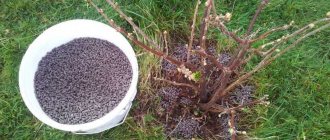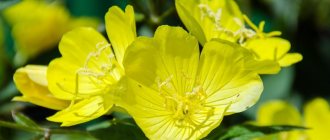Story
The tree peony is not a product of modern selection. It was known in China several hundred years ago. In Europe, the tree peony appears only in the 18th century.
The idea that the tree peony is a separate species is still considered controversial. Some scientists consider it only a set of hybrid specimens.
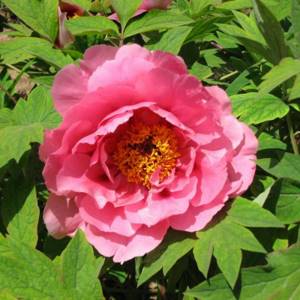
But no one doubts that the beauty and unpretentiousness of this plant deserves attention. Let's figure out why growing peonies is so popular.
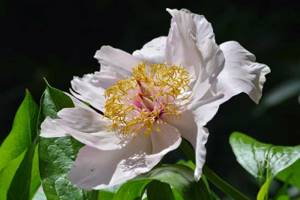
Varieties of pink and red tree peonies
The peculiarity of pink and red peonies is that each variety has an individual shade, unlike the others. The most delicate color and pleasant aroma have made them popular in all corners of the world.
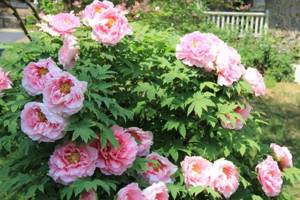
Flowers of pink and red tree peonies have wide, rounded petals
Lantian Jay
An unusually beautiful chalk pink peony with many wavy petals. The flowering process begins at the very beginning of summer, and the garden is filled with a sweet, subtle aroma.
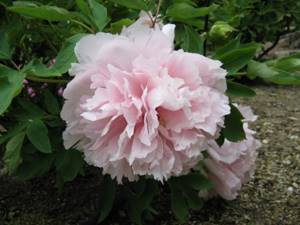
Lantian Jay is shaped like a beautiful pompom
Shima Nishiki (Shima-nishiki – Dao Jin)
An amazing creation of Japanese breeders. This variety appeared due to a natural mutation of the Tayo peony. As a result, the world saw a real masterpiece, consisting of almost white petals generously colored with cinnabar. Stripes and strokes of different widths intertwine with each other, forming natural patterns. In addition to the variegated one, this variety also has a completely monochromatic variety, which amazes with its rich red hue.
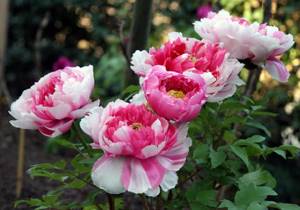
Shima Nishiki has about two dozen buds on a young bush
Rose powder (Fen he piao jiang)
Breeders managed to reproduce the shade of a delicate pink pearl, which shimmers, changing the depth of tone. The fragile beauty of this peony makes the heart skip a beat, and its ease of care makes this variety the most desirable among gardeners around the world.
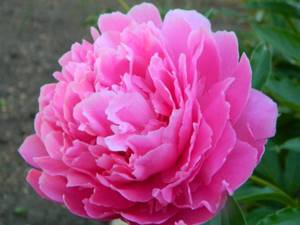
Tree peony Pink powder feels good in Russian latitudes
General characteristics of the plant
Any member of the family, regardless of the variety of tree peonies, has several common characteristics:
- It is a shrub, with a height ranging from one hundred and fifty to two hundred centimeters;
- The stems grow vertically. They do not wither in winter and gradually grow, acquiring a hemispherical shape;
- At the ends of the stems there are openwork leaves up to twenty centimeters long;
- The average flowering time is 21 days.
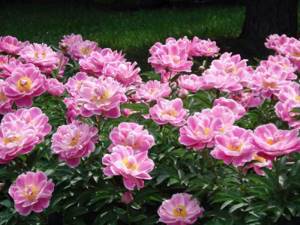
Tree peonies have good resistance to cold. This resistance increases with the age of the bush. The age of the plant also affects the abundance of flowering.

These parameters apply to all types of tree peonies. But it will be difficult to look at photos of tree peonies of each type, because there are more than 500 of them. Below we will look at a tree peony variety with a photo, but only with the most popular of them.
Own-rooted and grafted peonies
Tree peonies, based on the root, are divided into two types: rooted and grafted. Each of them has its own differences and subtleties.
With proper care, the root type of peonies lives for quite a long time (up to 20 years). It propagates easily by dividing bushes and is resistant to disease and winter cold.
But the plant also has its drawbacks. This type of tree peony blooms 5 years after planting. It develops slowly over the first 5 years. During this time, peonies grow to 60-70 cm.
The advantage of grafted peonies is rapid flowering. This is what they are grown for. In some cases, they can bloom even in the first year of planting. In addition, grafted peonies grow very quickly (up to 50 cm per year).
The big disadvantage of this plant is its fragility. It also cannot be propagated by dividing bushes; it does not tolerate transplantation well.
This type is formed by grafting a tree peony onto an herbaceous one.
It is very easy to distinguish these two species. When purchasing seedlings, pay attention to the root. Self-rooted peonies have many small thin roots of light brown color. But grafted peonies have thick roots.
You can plant two types of tree peonies at the same time. Thus, while some plants decorate the garden with their lush blooms, others will gradually develop.
Varieties
The main difference between tree peony varieties is in the flowers. Often, distinguishing one variety from another outside the flowering season is a problematic process.
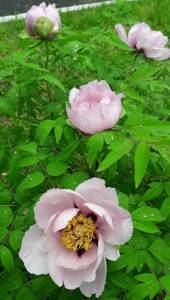
Despite the abundance of varieties bred by people. There are several original versions of the plant. It is worth noting that most of the basic varieties grow in China.

Planting and care
Choosing species for planting is the easiest thing. In order for a shrub to take root well and be a decoration, you need to know how to plant it and how to care for it.
Planting a tree peony
Planting a tree peony should be carefully prepared. There are several reasons for this:
- Peony grows in one place for a very long time. Some bushes can survive for a hundred years or more.
- Peony loves the sun. This means that there should be no large plants, trees, or buildings near the place where it grows.
- Peony grows best in loamy soil. Yes, this flower is unpretentious, but the more suitable the soil is for it, the more abundant the flowering will be. That is why when planting, the soil must first be prepared. If the soil is sandy, add fertilizer. If it’s too oily, use sand.
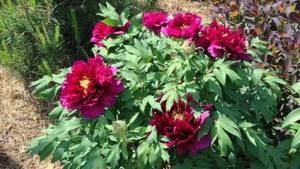
Varieties of purple and lilac tree peonies
This unusual color invariably attracts attention. Large flowers are arranged in a cluster and look impressive. Such plants are the highlight of any garden.
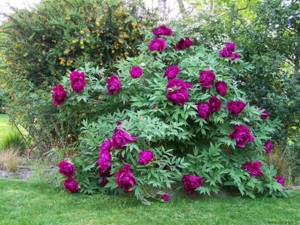
Purple and lilac tree peonies have an unusual color and large buds.
Imperial crown
Flowers of the Imperial Crown variety really resemble the crown of a monarch in shape. Cardinal-colored petals with a purple tint are raised upward, and the stamens appear to be covered with thin gold. In the sun they shimmer with hundreds of luminous sparks, like jewels. The key to generous flowering will be reliable shelter in the cold and proper care in the hot season.
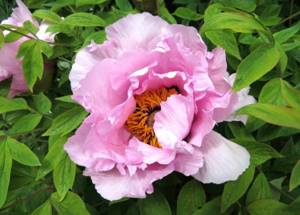
Imperial Crown - a spectacular variety with large flowers
Deep Blue Sea (Da Zong Zi)
The flowers of peonies of this variety are painted in raspberry-coral shades and against the background of lush, carved foliage they seem even more voluminous. Each petal is a small perfection captured in a unique form. Even after flowering, the bush remains attractive.
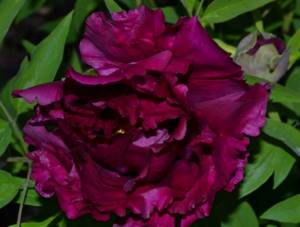
The deep blue sea pleases the eye until the first autumn frosts
Purple Ocean (Zi Hai Yin Bo)
This incredibly large flower blends deep purple and plum colors together. White strokes are applied to the petals as if with the thinnest mascara brush. Against the background of the overall gouache coloring, they look very gentle and make the flower look fatal and at the same time vulnerable and defenseless.
Read more When and how to properly transplant peonies to a new place in the spring
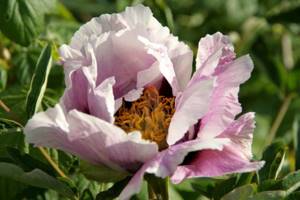
Tree peony Purple Ocean has an exquisite spicy-fruity aroma
Basic rules for planting a peony
The basic rules include:
- Adjusting soil acidity. Tree peony reacts sharply to soil acidity. Therefore, if the soil is acidic, you need to add two hundred grams of bone meal to the hole.
- Humidity adjustment. Before planting, it is necessary to create a drainage layer at the bottom of the hole. It is 20-30 centimeters. When creating it, you can use sand. Gravel. Or broken brick.
- The distance between bushes should be from one hundred fifty to two hundred centimeters.

Plant care
Tree peony care and cultivation, which does not cause much trouble, nevertheless requires knowledge of certain rules:
- Watering. The peony needs to be watered once every two weeks. At the same time, after watering it is necessary to carry out a number of procedures, including loosening the soil and removing weeds.
- Fertilizer. The plant requires sufficient amounts of nitrogen and potassium fertilizers. It is good to treat the root system with fertilizer before planting.
- Trimming. Peony should be pruned in spring. During pruning, shoots about ten centimeters long are left. Once every twenty years, the peony is pruned at the root.

Features of growing tree peonies in the Moscow region
Care in such an area requires the following features:
- Buy seedlings with open rhizomes. When purchasing, carefully consider it, choose those specimens in which the roots are practically intact. They must be clean, without a hint of rot or other imperfections that indicate the presence of fungus or parasite.
- Grafted peonies bloom beautifully and smell wonderful. Their roots are voluminous, natural dark brown. But they are more susceptible to the peculiarities of care, its changes and die faster.
- Self-rooted peonies do not bloom as luxuriantly, but they live longer. Their roots look weaker: thin and lighter.
- The shoots should not be longer than 20-25 cm; make sure that there are several healthy buds on the stems. Important: the specimen must be without leaves.
- If in some areas it is allowed not to produce complementary foods (when the soil is most suitable), then in the Moscow region it is advisable to use fertilizers every year. The order does not change: in the spring give preference to nitrogen preparations, and in the fall - to potassium-phosphorus preparations.
- It is better to trim diseased, wilted and dry shoots in the spring months; it is also advisable to shorten last year’s shoots by about 10 cm. The root shoots of grafted peonies are removed (they need to be cut off at the base).
- Adult specimens can be destroyed by gray rot or brown spot. For treatment, the most common Bordeaux mixture or copper sulfate is used. But the good thing about peony is that it is rarely exposed to parasites.
- Every 5-7 years it is better to replant the bush, divide it into several parts and plant it in different places (even though they don’t like it). The procedure will help rejuvenate the specimen and significantly extend its life. Therefore, you should not neglect this.
- Be sure to prepare the flower for winter. A delicate plant, whose homeland is in milder Asia, will not withstand the harsh winters of the Moscow region. Carefully insulate the plant.
Reproduction
Peony can be propagated in several ways:
- Dividing the bush;
- By cuttings;
- Vaccination.
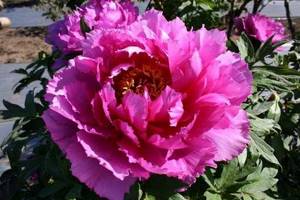
The tree peony, whose propagation is not difficult, is best done in the spring.
How to propagate a tree peony by grafting
The best time to graft a tree peony is the end of August. The rootstock is root segments of herbaceous or tree-like peonies 10-15 cm long; The thickness of the root should correspond to the thickness of the cutting. The roots are dug up 2-3 weeks in advance and kept in a cool place. Scion - only shoots of the current year, preferably with two eyes. Grafting with a wedge-shaped cut. Make a wedge-shaped cut on the rootstock. Cut the bottom of the scion into a wedge shape. The surfaces of the scion and rootstock must be completely smooth so that the cambial layers coincide. Insert the scion into the rootstock, tie tightly with insulating tape (sticky side out) and coat with garden varnish.
Grafted plants can be planted in the ground immediately after grafting. But it is better to first plant the grafted material for 3-4 weeks in a greenhouse protected from direct sunlight, leaving the graft above the soil level, and water it regularly. Another option is to keep the grafted material in the basement for 3-4 weeks - in a horizontal position, in 2-3 layers, layered with wet sawdust.
Lateral grafting. Cut the scion diagonally at a slight angle. Cut the root at the same angle. Tie the combined scion and rootstock tightly and coat with garden varnish.
- Author: admin
Rate this article:
- 5
- 4
- 3
- 2
- 1
(5 votes, average: 2.6 out of 5)
Share with your friends!

